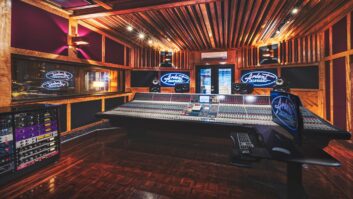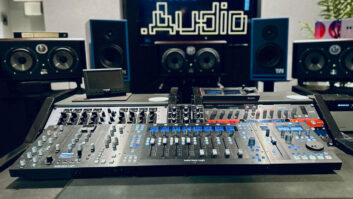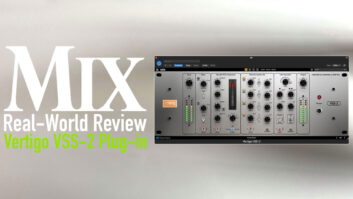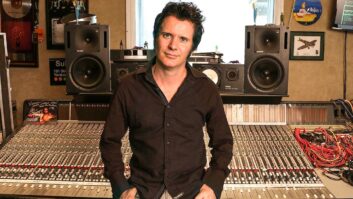Next to copy-protection threads, few subjects are more hotly debated in certain circles on the Internet than the proper way to use channels and speakers for mixing in surround. Though I usually spend more time talking to machines and chatting via e-mail, Mix asked me to play “talk show host” and ask some noted producer/engineers about how they incorporate the center channel into their surround mixes. You’ll find widely divergent opinions and some food for thought in the following excerpts from my conversations.
IN THE BEGINNING
Let’s start by talking about some of your projects.
Michael Bishop: I have some projects that are coming out soon on DTS-encoded CDs. Telarc just put together a DTS sampler of classical, jazz and blues 5.1 recordings. It contains a number of early experimental recordings. Another one is the Ray Brown Trio with guest Ulf Wakenius, a Swedish guitarist who plays for Oscar Peterson. That CD is called Summertime. Finally, there’s the Dave Brubeck Quartet’s So What’s New. It’s all new compositions.
Elliot Scheiner: The last surround project I did was a Roy Orbison record; I think it was his last live performance, Black and White Night. It was recorded at least ten or 12 years ago. It was fun for me to mix because the music is so wonderful, and it was nice to put it in that format.
Tom Jung: We’ve done three big band projects in discrete DTS, all of them set up a little differently, all of them mixed a little differently, while we experiment through this whole thing. They include The DMP Big Band Potpourri, The DMP Big Band Glenn Miller Project and The DMP Big Band Salutes Duke Ellington.
Nile Rodgers: We’ve done a live Chic project in 5.1. This is a tour we did a few years ago before Bernard Edwards passed away. There’s a stereo version coming out in America on my label, Something Else MusicWorks.
Kevin Beamish: The first surround album I did was Reba McEntire’s album in DTS format, If You See Him. It’s on its third hit [“Wrong Night”], and the first two releases, “If You See Him If You See Her” with Brooks & Dunn and “Forever Love” were Number One. I actually recorded and mixed the whole album in stereo and then did the 5.1 mix at a later date. Everything on that album was done at Starstruck Studios in Nashville. Another one I did is Colin Raye’s The Walls Came Down. I didn’t record it, but I mixed it in stereo and subsequently did the surround sound 5.1 mix.
THE CENTER CHANNEL
Okay, let’s get right to the point. What are your thoughts on the use of the center channel in mixing?
Jung: I mix with five matched speakers, as most engineers do, I think. One thing I mixed with the bass solid in the center channel-I think it was the first big band thing I mixed, the Glenn Miller Project. I walked into a home theater demonstration at CES where there wasn’t a center channel, and they were playing Glenn Miller without the bass in the center. So I’m saying, “Aw, man, we gotta rethink this.” I love the bass in the center channel. First of all, most left and right speakers end up in corners, which is horrible for exciting the room. So, of course, you’re exciting two corners now while trying to make a phantom channel out of these two speakers. It just makes so much more sense to me to have the bass localized. I think you get a higher-quality bass when you’re not feeding the playback room from a corner. And the beauty of it is-I mean, this is a subtlety that I get off on [chuckle]-when you move off-center, the bass doesn’t follow you. It stays in the center, and that’s something we’ve never been able to have before.
The Glenn Miller Project was mixed more discretely because at the time it was done-probably three years ago now-I didn’t have the tools to do what I can do today. With the 02R you can assign something in the center, you can assign something to phantom, and you can vary between phantom and center. Today, with more elaborate panning, I’ll use center speaker to the left speaker in the stereo image, the center speaker to the right speaker in the stereo image, and I’ll also use left and right: a combination of three frontal stereo images. If you’re listening on three equal speakers in the front, it works well. You’ll get a very controlled image, particularly when you’re not sitting in the middle [and it will work in less optimal situations]. This is used on The DMP Big Band Potpourri.
The other thing I did on that one is actually to bring the band around a little bit more, kind of wrap it around, not behind you, but almost between left front and left surround, and right front, right surround-say, 180 degrees-the front hemisphere, if you will. I’ve encouraged people who listen to our CDs to comment on it, and it’s surprisingly almost overwhelmingly positive. They liked the wrap-around. It does connect the front to the rear a little more. This includes panning and positioning and the returns of certain effects.
Bishop: I always use the center channel, in hopes that if people don’t have matched speakers now, sooner or later the people who are playing 5.1 music recordings will come around to have equal speakers. But I’m very careful about how I use the center channel in that anything I put there is duplicated somewhere else. I will have a phantom center channel between left and right in front with a duplicated center-front, but then perhaps 6 dB down, so it doesn’t build up too badly. That way, if the center channel is nonexistent, I’m finding that there are people playing 5.1 recordings on computer multimedia systems that have no center front. That’s pretty weird.
Beamish: I’m one of those who is very cautious about using the center channel. It’s not just because of certain systems’ lack of matched speakers; even if someone has a completely matched system, you still have to be real careful. It puts so much focus on anything you put in there-a little bit of lead vocal or lead vocal effect, sometimes a little kick drum, snare drum, a little bass maybe. If you’re doing a real dynamic panning effect, you might sweep it through the center channel, but that’s it. Just real limited amounts. To be honest, I could probably do without it. Surround sound to me is more equivalent to quad. It’s a difficult decision as to how to use it and when; just be really cautious. It’s not like in film, where you need the center for a dialog channel. If you’re not careful, it will get in the way of your surround sound mix.
[In my mixes], left and right still try to stay true to the original stereo mix, and then in the left and right surround, sometimes there will be discrete things; like if there are two or three guitar parts or an organ part and a piano part, they can be discrete. But for the most part, it’s ambiences and reverbs in the rear. That’s the way I do it.
Scheiner: Normally, I do put a little bit of lead vocal in the center. On [Steely Dan’s] Gaucho, it wasn’t dedicated to the center. We didn’t use much reverb on any of their stuff; the vocal was primarily in left and right front. Anything that I want a little more emphasis on, I’ll put in the center, which doesn’t amount to many things: bass, snare, kick and usually lead vocal. It’s so unimportant. I’m doing it that way because it’s there, but as Alan Parsons points out, there might be some systems in somebody’s house where they don’t have a center channel, where they don’t have the room, the TV’s sitting there. They can’t figure out where to put the speaker, so they’ve chosen not to put a speaker there.
I don’t put too much of anything in the center channel anymore. I made a mistake with The Eagles, and on one song, I put Henley’s voice just in the center speaker. This was the first time I had ever mixed in 5.1 and I didn’t think about any of the possible ramifications of putting it in there-as far as people having the ability to really “eyeball” this vocal on the center speaker, just turn everything off and go, “Uh-huh, uh-huh, I can hear a punch there.” So I won’t ever do that again.
Rodgers: My engineer, Gary Tole, and I talk about this all the time. Even though we’ve been recording together for a long time and I don’t do any projects without him, when we were working on this live project in the studio, we argued. We have almost totally drastic views, almost completely opposite.
I feel that if you’re doing a mix for 5.1, you should be mixing it for people who have those systems. Why do it if you’re not going to play it back in the medium that it’s meant to be played in? So the point is that if I’m using the center channel in a 5.1 mix, I want to use everything that’s there for me. For example, we just did a live record. Something that would be interesting in that situation is trying to transport the listener to the environment. If you’re sitting in an audience, there’s interesting stuff happening from your whole aural perspective. There’s stuff going on in front of you, behind you, all over the place, so it’s nice to put certain types of ambient effects in the center channel: applause, fidgeting around, whatever.
Gary Tole: Well, I would agree with what Nile said, that 5.1 is a new medium. There’s a new DVD-Audio format coming out, why not mix it to the way you’d want it to be, so that people will hear what you hear in the studio? In my opinion, there isn’t any hard and fast rule for using the center channel. It’s what works, and a lot of times with the center channel and voices, it gives you a depth and a perspective that you just can’t get out of a stereo mix. In the stereo mix, when you put something in the “center,” it’s not in the center. It’s coming out both channels-it’s a phantom. Now we have the capability of spreading out that spectrum. I would say it’s a truer stereo spectrum, because now you have a center in it; you get depth that you couldn’t get out of stereo before.
EFFECTS
Some people say, “Don’t use reverb in the center channel, you’ll get comb filtering when combining that with left and right.” How do you feel about that? Do you leave the vocalist or instrument naked? What kinds of effects are useful?
Beamish: If you put too much of anything, specifically lead vocal, in the center, it really focuses your ear on it. That might work for somebody’s records and mixes, but for mine, which are more three-dimensional anyway, even in stereo with utilizing significant amounts of reverb, to just put a dry vocal in the center sounds naked and unnatural.
The idea of a stereo mix with stereo reverbs…everything kind of washes into that stereo. If you use a dry vocal in the center, obviously you can’t use any stereo reverbs mixed down to mono because they just tend to phase in the middle. You could use a mono reverb, I suppose, but you could say it’s basically not necessary. I leave the vocal dry in the center and use very little bits of it. Same thing applies to the kick drum and snare drum. Bass seems to do a little bit better than all the others because there’s not that much attack on it.
Scheiner: I keep it dry. Everything that I put in the center I keep dry. As long as the center speaker is there, I’ll put something in it, but not very much.
Tole: Since most of my stuff is live, I only add a little ambience. I did a mix with Patti Smythe for the Armageddon soundtrack. The way I mixed it since we weren’t on a Capricorn or a console that was set up for it was by busing and panning. I kept the vocals in the center channel, and all the effects I pretty much kept in the left-right spectrum. Some of them I panned, like if I had certain instruments panned off to the side and I wanted all of them discrete in the environment, I’d just pan the reverbs that way, too.
Rodgers: I was thinking as Gary was talking, that I like to think of every song as its own performance. I don’t like to think that I’m going to have a uniform approach to anything and it’s always going to be that way. If I’m working with an artist where the vocal has its own sense of dynamics and perspective, I may want to heighten that or lessen that depending upon that performance and what the instruments are doing. You would think that with a format like 5.1, it would really lend itself to artistic interpretation of a performance. In other words, you could really enhance an artistic performance. To me, that would be the cool thing. The artistic approach to music has always been the most important thing to me. When you can expand on a performance or when you can create some additional magic, that’s where it’s at, and that’s why I’m totally excited about 5.1.
Bishop: I never intentionally put reverb on the center channel because of the strange mixture that can happen, since not everybody puts that center channel where it needs to be, which is equidistant from the listener. That center front channel should be in the middle of an arc in front of the listener. Right now I’m working on the 5.1 version of another Ray Brown Trio record with a lot of guest vocalists. And that guest vocalist is not only a phantom center but also rock-solid in the center channel. But about 6 dB down. The reverb is in the left and right, not in the center, and it’s also continued into the surrounds. But I have to be very careful about how I’m using the center because, for one thing, nothing can ever exist only on that center front channel. It may not exist on some systems, or, as many have pointed out, it may only be a 3-inch speaker under the TV. And all of us who have been working in this awhile have made that mistake of dedicating something to that channel until you hear it on some multimedia system, and boy is that a shock.
Jung: The key to using reverb is not to put the same reverb in the center channel that you put in left and right. When I’m using my overhead channel, I have six discrete channels with noncorrelated reverb. Someone should make a 6-channel reverb.
MIKING
What about miking? How does that affect the center channel? With a single vocalist you might choose one technique, but with other situations what would you suggest?
Bishop: Working with a vocalist, I would do it simply with panning and busing in some instances, and with a phantom center as well. For instance, on a Maria Muldaur CD that we also have coming out in the DTS format [Southland of the Blues], there’s some instances where I’ll take the lead vocal and put it into all the channels-a bit in center front and also into the other four speakers to bring it into the center of the room, but anchor it a bit toward the front as well, so it will have some solidity. There are times when you want it to float around, so you do that all with panning. In the orchestral recordings, I mike specifically for the center channel. That’s the typical left-center-right pickup, but I do have to distribute some of that center microphone between left and right front because in an orchestral recording, if you lose that center front channel due to a deficient center speaker, it’s pretty awful.
THAT LEFT-RIGHT SPEAKER ANGLE
What about the angle of the left and right speakers with regard to the center? I know there has been a lot of controversy concerning this on the Net. The new THX PM3 small-room guidelines are geared more toward a narrower angle (like the traditional mix rooms for film), while a lot of other people say that having a center channel gives stability in the front, so you can split the left and right speakers wider. Still others say that splitting them wide destroys the image; in fact, a recent article in the AES Journal discussed improving stereo imaging by closely spacing the speakers with a ten-degree angle rather than the 60-degree angle long preferred by audio engineers mixing in stereo. What are your feelings about this?
Beamish: To be perfectly honest, I have the dimensions of a setup that I use that I just came to, not by scientific theory, mathematics, physics or anything else, but by the fact that it sounded right. The bottom line is that when this product gets to the consumer, there is no standard. You really have to think about where you’re going. It’s nice to have perfect monitoring, but the idea of surround sound is people at a party in someone’s living room being able to get the essence of the mix whether they’re standing in the front or in the back. I’ve found that with regard to the angle issue, the left and right surrounds sound better with a narrower angle than the left and right fronts. I’ve got 86 inches from the center of the left front to the center of the right front, and I’ve got 72 inches between left and right surround.
Jung: Well, it’s funny you should mention that because just last week I was becoming unsatisfied with 60 degrees. I don’t think it’s making use of the three front channels. My basic criterion was that if I moved left and right 40 degrees from center (an 80-degree angle), do I compromise the stereo image, and the answer was “yes.” So I came back and I’m around 38 degrees now (76 degrees between left and right). I played around for a couple of days just finding that right spot so the stereo was at the outer limit when I wasn’t using the center channel, so I had a really good phantom center. Yet, I wanted to get the left and right out as far as I could so I could make the whole frontal stereo, the three-speaker front, have even more control. Currently, I feel good about that because I do feel that the 60-degree angle between left and right is a little too narrow if you’re actively using the center channel. Of course, you also have the surrounds out at 110 degrees, so it makes all the more sense to open up the fronts a little bit.
Scheiner: I’ve never mixed any other way than with 60 degrees. I don’t think it’s going to make a big difference. I believe the surrounds are going to be different in everybody’s house. How many homes are going to have enough room to put speakers in the rear?
Bishop: I tend to go with the 60-degree setup but end up moving things around a bit. We have so many different control room setups since all of our recordings really are on location, whether we’re doing a jazz recording in a club or an orchestral recording in a hall. First, I set up the left and right front so they sound correct in stereo. I’ll play a stereo recording through that to get proper imaging and then go to a reference 5.1 recording and check everything. I have to first get the left-right working correctly, since any good 5.1 recording does rely on phantom images. If you can’t get the imaging correct between left-right-front, you’re not going to have any good phantom images. The surround is really where I see more movement of speakers. Many people have surrounds on walls in the rear, or even worse, up in the ceiling. That’s going to be pretty difficult as we’re getting more into recordings that are made particularly for surround as opposed to stereo.
In some of the classical things, as we’re looking for things that are suited to surround, some of the 16th-century Gabrielli pieces that were meant to be performed in the round, they’re just ideal for that. We’re recording with the Mormon Tabernacle Choir. There are orchestral pieces with antiphonal choirs where they’ll have the main group in the front and the answering groups from the sides or rear. There were a lot of pieces that were written that way and were meant to be performed that way. We’ve been able to record them, but nobody could ever play them back at home, and that’s what’s broken all this open-having a reliable playback medium.
CODA
A big thank you goes to Pascal Sijen, who added background material. Although it was beyond the scope of this discussion, it certainly helped me to formulate the proper questions. As Michael Bishop said, “It’s only one speaker, but it’s sure causing a lot of trouble!” For those who still like to experiment and get into trouble, the center channel remains a focus of attention and a rich area for exploration.







